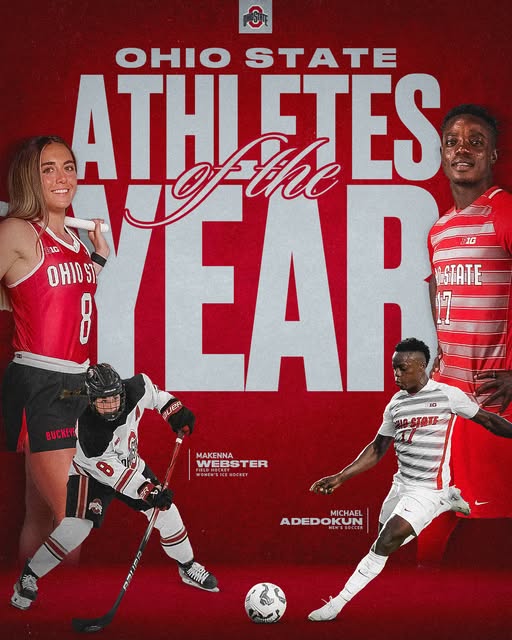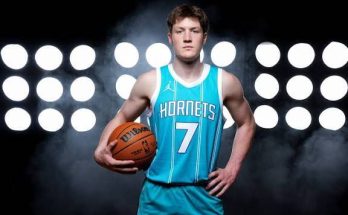Here’s a 1,500‑word flow‑style blog post celebrating the exceptional achievements of Ohio State’s 2024–25 Athletes of the Year, Michael Adedokun and Makenna Webster:
When the Ohio State Buckeyes announced their Athletes of the Year for the 2024–25 academic year, the choices spoke volumes about excellence, versatility, and trailblazing spirit. Michael Adedokun, the prolific midfielder from the men’s soccer team, and Makenna Webster, a dual‑sport powerhouse in field hockey and women’s ice hockey, stood atop a field of remarkable talents across the Buckeye athletic spectrum. Their stories, contributions, and impact reflect a mix of historic firsts, unrelenting dedication, and a commitment to pushing both personal and program boundaries.
Michael Adedokun arrived at Ohio State in 2023 after a strong career with the Dayton Flyers. Once on campus in Columbus, he immediately began redefining what Buckeye soccer success could look like. In the 2024 season, Adedokun found his stride. He became the first player in Ohio State men’s soccer history to win the prestigious MAC Hermann Trophy — college soccer’s version of the Heisman — an honor crowning not just a stellar season but a groundbreaking one (elevenwarriors.com). Leading the Big Ten with 11 goals and 11 assists, he racked up 33 points, guiding the Buckeyes to a dominant 16‑2‑4 record, a share of the Big Ten regular‑season title, a tournament championship, and their second ever trip to the College Cup (elevenwarriors.com).
Adedokun’s influence extended far beyond the score sheet. His dynamic play earned him First Team All‑America status and the distinction of Big Ten Midfielder of the Year (en.wikipedia.org). He helped lead Ohio State to its inaugural No. 1 national ranking and the top overall seed in the NCAA tournament (ohiostatebuckeyes.com). His technical skill, field vision, and tireless effort underpinned a season of breakthrough success for a program long hungering for national recognition.
Born in Eruwa, Nigeria, and a product of the Segun Odegbami high school in his hometown, Adedokun brought to campus not just talent but resilience and drive. On and off the field, he was recognized as a scholar‑athlete (ohiostatebuckeyes.com). His journey from a fruit stand in Nigeria to campus practice fields in Columbus, and now to professional ranks — he was selected in the first round of the 2025 MLS SuperDraft by CF Montréal and loaned to Lexington SC (en.wikipedia.org) — echoes themes of determination and excellence. That Ohio State honored him as Male Athlete of the Year was a fitting salutation to a player whose influence reshaped the trajectory of the program .
While Ohio State athletes frequently shine in one realm, Makenna Webster offers a blueprint for versatility at its finest. A native of St. Louis, Missouri, Webster transferred from Wisconsin to Ohio State in 2022 with a clear goal: to play two sports. She arrived with a national championship in ice hockey under her belt, having been named Frozen Four Most Outstanding Player (alumnimagazine.osu.edu). But her fire burned for field hockey as much as for ice hockey. Her determination, trademark work ethic, and enthusiasm convinced coaches in both programs to build schedules and training around a two‑sport athlete .
On the field hockey pitch in 2024, Webster racked up 42 points — ranking among the top eight nationally — and led the Buckeyes to a 14‑5 record with six wins over ranked opponents (ohiostatebuckeyes.com). She became the first Buckeye in nearly three decades to post consecutive 40‑point seasons (ohiostatebuckeyes.com). Her dominance earned unanimous First Team All‑Big Ten honors and a Second Team All‑America selection (ohiostatebuckeyes.com). She also secured the Big Ten Medal of Honor, spotlighting excellence in athletics, application, and academics (ohiostatebuckeyes.com).
Her ice hockey contributions matched her field performance. In just 30 games, she posted 35 points (12 goals, 23 assists), a scoring pace that placed her among the top 15 nationally in assists and points per game. She helped propel the Buckeyes to their fourth straight appearance in the national title game (ohiostatebuckeyes.com). Her ice hockey success continued beyond Ohio State: she was the 17th overall pick in the 2025 PWHL Draft, joining the New York Sirens (ohiostatebuckeyes.com).
Managing schoolwork, two sports, and a nationally‑ranked life required uncommon organization and maturity. Detailed color‑coded schedules and open communication between coaches enabled Webster to avoid burnout and stay academically on track — she’s majoring in communication (alumnimagazine.osu.edu). Coaches noted that beyond her raw skill, Webster’s humility, character, and consistency were invaluable. She did the little things that make a team successful and raised the bar for teammates (alumnimagazine.osu.edu). Her presence galvanized teammates: field hockey and ice hockey players showed heartfelt support at each other’s games, a testament to Webster’s impact off the stat sheet .
Ohio State’s bold choice to name Webster the Female Athlete of the Year recognized far more than numbers — it honored her leadership, dual‑sport mastery, and ability to elevate two programs simultaneously . Her journey reflects resilience, intelligence, and vision. When both ice and turf collide, Webster is proof that ambition, when coupled with meticulous planning and support, can redefine what is possible for student‑athletes at the highest level.
Beyond individual accolades, Adedokun and Webster now move on to compete for Big Ten Athlete of the Year honors, a testament to their success across the entire conference (elevenwarriors.com). Both are fifth‑year seniors whose Buckeye careers have reached their peak, and both leave behind records, traditions, and programs that will feel their absence.
Adedokun leaves a mark as the first Buckeye to win the MAC Hermann Trophy, to lead the Big Ten in points, goals, and assists, and to lift the program to heights previously unseen — a coveted College Cup semifinal, national No. 1 ranking, and tournament seeding. His journey from Nigeria to pro soccer encapsulates dreams realized through hard work, raw talent, and an unyielding belief. Webster leaves a template in collegiate athletics — of pursuing dual passions without compromise, of organizing every aspect of life with intention, of showing that leadership shines through scores on the board as much as through character in the locker room.
Their dual achievements prompt a reflection on the evolving landscape of college sports: the increased emphasis on multi‑sport athletes, mental agility, and academic support. Webster’s story, in particular, underscores how supportive institutional structures — from coaching staff collaboration to schedule management — can empower student‑athletes to pursue multi‑faceted excellence. As Title IX turns 52 in 2025, Webster’s success is a reminder that providing flexible pathways for athletes enriches programs and catalyzes individual achievement (elevenwarriors.com).
Ohio State’s recognition of Adedokun and Webster is both deserved and strategic — it projects a message that winning isn’t confined to traditional powerhouses or individual sports. Their honors serve to attract future talent who crave programs where excellence is holistic, character is valued, and innovation is encouraged. A midfielder who rewrote school history and a dual‑sport standout who juggled ice and turf with aplomb — their legacies will inspire.
These two athletes also share themes of international reach. Adedokun’s Nigerian roots and Webster’s journey between Midwestern U.S. and global ice hockey networks highlight Ohio State’s growing identity as a program that attracts and develops global talent. It underscores the university’s ongoing efforts to become a destination for athlete‑scholars with diverse backgrounds and ambitions.
The decision to name both Adedokun and Webster Athletes of the Year may also recalibrate expectations for program leaders. It’s a message that leadership isn’t singular, that multisport prowess is worthy of the highest honors, and that the bar for success is constantly rising. Their accomplishments raise the question: What might the future look like if more student‑athletes were supported in playing more than one sport, or if infrastructure across athletic departments fostered greater flexibility?
As both prepare for the next chapter — Adedokun as a professional starter in North American soccer, Webster joining the PWHL and continuing to push the women’s game to new heights — Ohio State fans and future recruits will remember a season that changed expectations. They’ll recall an athlete from Nigeria who transformed a soccer program and another from St. Louis who refused to choose between ice and turf. They’ll recall a season where the Buckeyes not only celebrated history and versatility but also suggested a future filled with possibility.
Adedokun and Webster’s achievements in 2024–25 stand as testimony to a university that nurtures excellence, fosters personal growth, and celebrates innovation. They redefined what it means to be a Buckeye athlete in 2025 — not just by winning awards, but by pioneering paths, balancing complexity, and inspiring two programs at once.
In fields and rinks stamped scarlet and gray, their names are now indelible. Their journeys remind us that history is re‑written, talent is multidimensional, and universities can be launchpads, not cages, for aspirations. As Adedokun’s sprint down the sideline or Webster’s swift transition from turf to ice become memories, Ohio State’s Buckeye Nation will carry forward an elevated standard, animated by the example of two Athletes of the Year whose brilliance went far beyond stats and trophies.
It may be many seasons before any future contenders leave such a comprehensive mark. But as long as college sports reward those who foster innovation, character, and achievement across platforms, the legacy of Michael Adedokun and Makenna Webster will continue to shine — a powerful reminder that greatness transcends lines, fields, and lectures.



